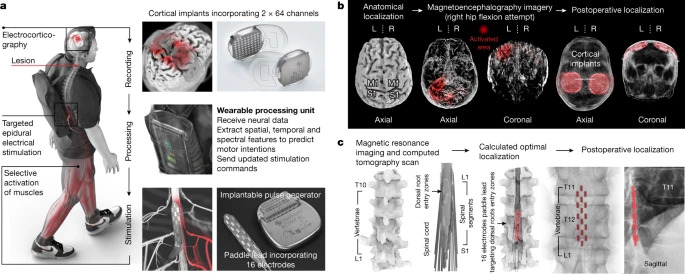Published on
Updated
Reading 2 mins.
A collaboration between Swiss and French researchers has achieved what was unthinkable just a few years ago: thanks to electrodes, Gert-Jan, a paraplegic for 12 years, has rediscovered a connection between his brain and his spinal cord, and can thus “decide “to walk.
Stunning and incredible images! A team of Swiss and French researchers succeeded in making a 40-year-old man, paraplegic since a bicycle accident 12 years ago, walk again, by translating his thoughts into electrical impulses in his legs.
An implant capable of translating intentions
The man has thus found an almost natural movement, while his body itself is not repaired. How is it possible? We put the question to Henri Lorach, a researcher at the Ecole polytechnique fédérale de Lausanne involved in this cutting-edge work.
“Normally, it is the motor cortex in our brain that will deliver motor information to the muscles through the spinal cord. However, in someone who has had an accident, the communication between the cortex the brain and the muscles is interrupted. What we have done is an implant on the surface of the brain capable of recording electrical activity while the patient tries to make a movement. We are therefore able to see the electrical modulations of the brain linked to each intention, which we link to stimulation of the spinal cord under the lesions, to activate the neurons responsible for movements in the legs”.
At the level of the spinal cord, the patient therefore has 16 electrodes, each of which activates a group of muscles, making it possible to restore particular movements such as the flexion of the hip or the knee, decided by motor intentions of the brain.

Moving by mere thought becomes possible
The system, which took years to set up, was nevertheless fairly quickly successful with the patient.
“Surprisingly, once the system was perfected, the paraplegic patient quickly managed to make a model work. Typically, it was enough to ask the patient to repeat an intention to make a movement about ten times, to for the algorithm to detect this particular signature and for the patient to be able to naturally control the stimulation, as healthy people do naturally”, nWe learn the researcher.
“I can decide when I walk, I have all the control”indeed confirms the patient at the heart of this feat.
Getting your arms and hands moving tomorrow?
The technology will still have to be perfected for many years to be accessible to as many people as possible, but the research team does not intend to stop at this victory. She is preparing to carry out new studies to apply her model to paralysis of the arms and hands.
“We are in the recruitment phase for this study, in which this time we will stimulate the cervical spinal cord, for the arms and hands. Our goal is to work on the different muscles to produce a functional task. But that’s yet another challenge, because there are more degrees of freedom in arm control than in leg control. We are going to push the limits of the system even further to decode the intentions of these movements and provoke them through stimulation”.
To be continued…
